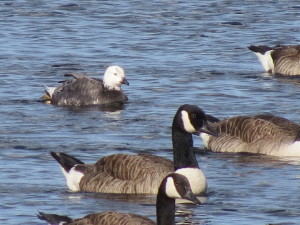Wildlife Diary 3rd August
Whilst there is a real hint of autumn in the air around highland Perthshire, we are bathed this week in lovely sunshine. There are small touches of autumn colour on the lochside trees and the numbers of geese are building daily.
Today we had another visit from a hybrid Barnacle goose who has been living with the local Canada geese population for the last year or so. The small delicate build and the small tapered bill look very barnacle goose like , but the colouration is a real mystery, as it its full parentage.

Hybrid geese and ducks are actually quite common , though some species hybridise more often than others- such as Canada geese and Mallards. They will court and mate with domestic waterfowl and even sometimes interbreed with other wild species, though the offspring are almost always sterile themselves and cannot breed successfully.
Autumn migration is a time when we often get sightings and questions of unusual birds , so if you see a duck or goose or any bird that looks really odd, it is worth checking out three possibilities:
1) It is a Vagrant– that is a species not usually found in the UK , but lost on route or blown off course by storms- check the “Unusual visitors ” section of any decent bird book. A good example of this would be Snow geese who are usually found in the Americas, but who sometimes turn up in the UK following Greylag, Barnacle or Pinkfoot goose flocks in winter. The above individual does look like a small, grey colour form snow goose, but its bill is the wrong colour and shape.
2) It could be an escaped captive individual or its descendants- this is particularly common in geese and ducks who are often kept in domestic settings. For example a few years ago we had a trio of white headed Bar Headed geese on the loch, who are normally found migrating over the Himalaya, and who on closer inspection were escaped pets- look for leg rings and tame behaviour.
3) It could be a hybrid individual– you can have hours of fun trying to figure out the combinations. A good bird book should have a page of common hybrid illustrations for ducks and geese, such as Canalags ( Canada x Greylag geese) , Pochard or Scaup x Tufted Duck and so on.
If you see large flocks of autumn birds, it’s always a good idea to take time to scan the flock and see if there any unusual individuals that stand out- many a rarity has hidden amongst common friends- Good luck with your autumn migration watching!
Ranger Emma
Help protect Scotland’s wildlife
Our work to save Scotland’s wildlife is made possible thanks to the generosity of our members and supporters.
Join today from just £3 a month to help protect the species you love.
Preface
Whilst there is a real hint of autumn in the air around highland Perthshire, we are bathed this week in lovely sunshine. There are small touches of autumn colour on …
